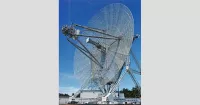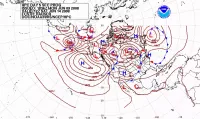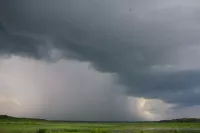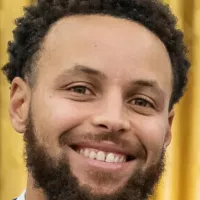Weather radar is a crucial tool for detecting precipitation, assessing its movement, and determining its type. Modern Doppler weather radars go further, measuring the velocity of rain droplets. This advanced capability allows meteorologists to analyze storm structures and predict the likelihood of severe weather events. By providing real-time data on precipitation intensity and movement, weather radar plays a vital role in issuing timely warnings and protecting lives and property from the impacts of hazardous weather.
1900: Galveston hurricane
The 1900 Galveston hurricane killed an estimated 6000-12000 people.
1950: Reflectivity radars incorporated worldwide
Between 1950 and 1980, reflectivity radars, which measure the position and intensity of precipitation, were incorporated by weather services around the world. Early meteorologists had to watch a cathode-ray tube to observe data.
1950: Airborne radar equipment demonstrated
In 1950, the UK company EKCO demonstrated its airborne 'cloud and collision warning search radar equipment'.
1953: First radar observation of a "hook echo"
In 1953, Donald Staggs, an electrical engineer working for the Illinois State Water Survey, made the first recorded radar observation of a "hook echo" associated with a tornadic thunderstorm.
September 1961: First use of weather radar on television during Hurricane Carla
In September 1961, during Hurricane Carla, reporter Dan Rather broadcasted live from the U.S. Weather Bureau WSR-57 radar site in Galveston, using a transparent overlay to show the storm's size and location to viewers. This was the first use of weather radar on television.
1964: NSSL experimentation
In 1964, the NSSL (National Severe Storms Laboratory) began experimentation on dual polarization signals and on Doppler effect uses.
May 1973: NSSL documents tornado life cycle
In May 1973, a Dopplerized 10 cm wavelength radar from NSSL documented the entire life cycle of the tornado that devastated Union City, Oklahoma. Researchers discovered a mesoscale rotation in the cloud aloft before the tornado touched down.
April 1974: Super Outbreak of tornadoes
The Super Outbreak of tornadoes on 3–4 April 1974, and their devastating destruction might have helped to get funding for further developments in weather radar technology.
1980: Reflectivity radars incorporated worldwide
Between 1950 and 1980, reflectivity radars, which measure the position and intensity of precipitation, were incorporated by weather services around the world. Early meteorologists had to watch a cathode-ray tube to observe data.
1980: Weather radar networks become the norm
Between 1980 and 2000, weather radar networks became the norm in North America, Europe, Japan and other developed countries. Conventional radars were replaced by Doppler radars.
1985: King City station constructed
In 1985, Environment Canada constructed the King City station, with a 5 cm research Doppler radar.
1988: Construction of NEXRAD network begins
In 1988, the United States started constructing NEXRAD or WSR-88D (Weather Surveillance Radar 1988 Doppler), a network consisting of 10 cm radars, following NSSL's research.
1993: McGill University dopplerized its radar
In 1993, McGill University dopplerized its radar (J. S. Marshall Radar Observatory).
1998: Complete Canadian Doppler network
Between 1998 and 2004, Canada established a complete Doppler network.
2000: Research on dual polarization technology
After 2000, research on dual polarization technology moved into operational use.
2000: Objects misinterpreted by weather radars
As of 2000, Objects can be misinterpreted as rain or snow by weather radars. Insects and arthropods are swept along by the prevailing winds, while birds follow their own course.
2000: Weather radar networks become the norm
Between 1980 and 2000, weather radar networks became the norm in North America, Europe, Japan and other developed countries. Conventional radars were replaced by Doppler radars.
March 2003: Park Forest, Illinois, meteorite fall
On 26 March 2003, the Park Forest, Illinois, meteorite fall occurred.
2003: National Science Foundation establishes CASA
Also in 2003, the National Science Foundation established the Engineering Research Center for Collaborative Adaptive Sensing of the Atmosphere (CASA).
2003: NOAA experiments with phased-array radar
Since 2003, the U.S. National Oceanic and Atmospheric Administration has been experimenting with phased-array radar as a replacement for conventional parabolic antenna to provide more time resolution in atmospheric sounding.
2004: Complete Canadian Doppler network
Between 1998 and 2004, Canada established a complete Doppler network.
2005: Environment Canada radar dual-polarized
Another Environment Canada radar, in King City (North of Toronto), was dual-polarized in 2005; it uses a 5 cm wavelength, which experiences greater attenuation.
2008: NEXRAD added extra resolution of data
In 2008, US NEXRAD radar network added extra resolution of data.
2009: Wind farm interference with radar
In 2009, an event occurred in Dodge City, Kansas, where the radar generated false positives for the tornado vortex signature algorithm due to the rotating blades of windmills on modern wind farms returning the radar beam to the radar.
April 2013: All United States National Weather Service NEXRADs dual-polarized
In April 2013, all United States National Weather Service NEXRADs were completely dual-polarized.
April 2013: NEXRAD radars equipped with dual-polarization
NOAA equipped all its 10 cm NEXRAD radars with dual-polarization, which was completed in April 2013.
2014: NEXRAD additional intra-cycle scanning
In 2014, US NEXRAD radar network added additional intra-cycle scanning of the lowest level elevation (MESO-SAILS).
2023: Tomorrow.io launches space-based radar
In 2023, the private American company Tomorrow.io launched a Ka-band space-based radar for weather observation and forecasting.
Mentioned in this timeline

Radar is a radiodetermination system using radio waves to detect...

Weather forecasting employs scientific and technological methods to predict atmospheric...

Thunderstorms also known as electrical or lightning storms are characterized...
The National Weather Service NWS is a US federal agency...

A tornado is a rotating column of air connecting the...
Alabama is a state in the Southeastern United States bordered...
Trending

19 days ago Sabrina Carpenter slams Trump White House for using 'Juno' in ICE video.
1 month ago Dylan O'Brien Stars in Sam Raimi's Outrageous Horror Comeback, 'Send Help'
2 months ago Amy Poehler and Tina Fey Reunite on SNL for Political Satire and Humor

4 months ago Colorado Lottery results: Pick 3 Midday and Evening winning numbers for August 14, 2025.

6 months ago Ariana Grande mourns the loss of her grandmother Marjorie 'Nonna' Grande at 99.

1 month ago Warriors' Commitment Questioned After Loss; Green, Butler Criticize Teammates; Curry's Reaction?
Popular

Candace Owens is an American conservative political commentator and author...

Tucker Carlson is an American conservative political commentator known for...

XXXTentacion born Jahseh Dwayne Ricardo Onfroy was a controversial yet...

Ben Shapiro is a prominent American conservative political commentator media...

Kashyap Pramod Patel is an American lawyer who became the...

William Franklin Graham III commonly known as Franklin Graham is...
